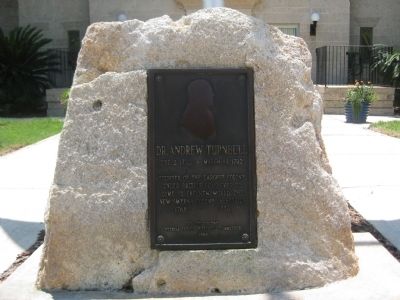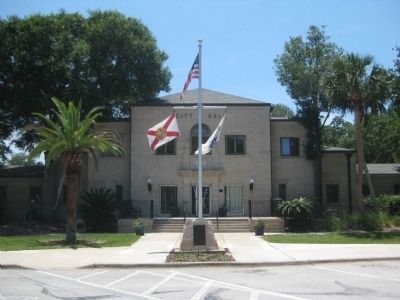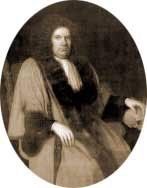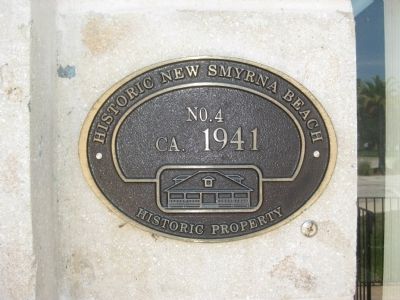New Smyrna Beach in Volusia County, Florida — The American South (South Atlantic)
Dr. Andrew Turnbull
Dec. 2, 1720 - March 13, 1792
Founder of the largest colony under British rule ever to come to the New World. The New Smyrna Colony of Florida
Erected 1968 by the Volusia County Historical Commission.
Topics. This historical marker is listed in these topic lists: Colonial Era • Settlements & Settlers. A significant historical year for this entry is 1768.
Location. 29° 1.604′ N, 80° 55.385′ W. Marker is in New Smyrna Beach, Florida, in Volusia County. Marker is on Sams Avenue north of Julia Street, on the right when traveling south. In front of New Smyrna Beach City Hall. Touch for map. Marker is at or near this postal address: 210 Sams Avenue, New Smyrna Beach FL 32168, United States of America. Touch for directions.
Other nearby markers. At least 8 other markers are within walking distance of this marker. To the Past... (within shouting distance of this marker); Anniversary of Shelling by Union Gunboats (about 400 feet away, measured in a direct line); The Connor Library (about 400 feet away); New Smyrna Museum Of History (about 500 feet away); Site of Sheldon's New Smyrna Hotel (about 500 feet away); Emory L. Bennett Park (about 500 feet away); 1768 British Colony of New Smyrna (about 500 feet away); Turnbull Canal (about 700 feet away). Touch for a list and map of all markers in New Smyrna Beach.
More about this marker . The marker is a rectangular metal plaque mounted on a rock. It sits below a flag pole and faces away from City Hall toward the street. Across the top of the plaque is a cameo outlining a man's profile. The marker sits within the nationally designated New Smyrna Beach Historic District.
Regarding Dr. Andrew Turnbull. Born in Scotland, Dr. Andrew Turnbull was a physician and British diplomat who was granted lands in the newly British territory of East Florida. He sailed there with with 1200 - 1400 Greek, Corsican, Minorcan, Italian, and other immigrants to establish the 101,400 acre colony of New Smyrna (named for Smyrna in Asia Minor, birthplace of Turnbull's Greek wife). The colony successfully cultivated sugarcane, indigo, and hemp, but suffered significant losses resulting from disease and discord with their Native American neighbors. Increasing dissension among the remaining colonists finally brought about the colony's collapse, and the settlers retreated north to St. Augustine. Florida later reverted to Spanish authority and Turnbull retired to South Carolina.
Also see . . .
1. Archeological Resources of the 18th-Century Smyrnea Settlement of Dr. Andrew Turnbull MPS. Wikipedia entry:
Several archaeological sites related to Turnbull's colony are listed with the National Register of Historic Places, and include canals and building sites. (Submitted on April 9, 2014, by Glenn Sheffield of Tampa, Florida.)
2. Smyrnea: Dr. Andrew Turnbull and the Mediterranean Settlement at New Smyrna and Edgewater, Florida. Florica History Online website entry (Submitted on July 1, 2014, by Glenn Sheffield of Tampa, Florida.)
Credits. This page was last revised on January 24, 2024. It was originally submitted on April 9, 2014, by Glenn Sheffield of Tampa, Florida. This page has been viewed 1,055 times since then and 28 times this year. Photos: 1, 2, 3, 4. submitted on April 9, 2014, by Glenn Sheffield of Tampa, Florida. • Bernard Fisher was the editor who published this page.



